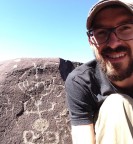Double Springs Camp
Following the abandonment of the Mormon Lake area by Little Colorado River settlers by the late 1880s, the lands saw sporadic logging and ranching activities until the 1930s, when the Great Depression spurred the creation of federal programs aimed at creating recreational and forest management infrastructure across America’s public lands. In 2016, Cornerstone recorded the remains of Double Springs Camp (F-6-A), a Civilian Conservation Corps (CCC) camp overlooking the western edge of the lake. The CCC operated between 1933 and 1942, established by President Franklin D. Roosevelt to generate jobs for struggling Americans during the Great Depression (Otis et al. 1986).

Figure 1. 1936 Overview Photograph of Double Springs Camp (F-6-A), Facing East towards Mormon Lake (Courtesy Coconino National Forest).
Created through the Emergency Conservation Work Act (ECW), part of Roosevelt’s larger New Deal, the program developed and expanded infrastructure within many of America’s National Parks (Moore 2006). Workers constructed fire lookouts, fought wild fires, established trails and campgrounds, built roads, set up telephone lines, and provided erosion and soil control. CCC projects emphasized a minimalistic design that strove to blend into the immediate surroundings. The ranger stations and visitor centers built during this period used locally sourced materials that were designed to complement the landscape. The CCC performed projects large and small at national parks and monuments across the country. Surviving structures at the Grand Canyon, Sunset Crater, Walnut Canyon, and Wupatki are wonderful examples of the legacy of the CCC.
The Double Spring Camp was established in June 1933 by Company 863, one of the first CCC groups active within the Coconino National Forest (Pilles 1994). Company 863 originally consisted of 184 enrollees, mostly from Texas and Arizona (Moore 2006). Enrollees were provided a flat salary of $30 per month and were required to serve for a period of six months. Summer seasons were spent establishing and upkeeping facilities around Mormon Lake; during the winter months, the company transferred to lower elevation areas within the Verde Valley. Company 863 occupied a number of diverse roles while at Double Springs Camp, such as the eradication of prairie dog and porcupine populations around Mormon Lake; the rodent burrows represented a risk to livestock, which could injure their legs falling into the holes (Audretsch and Hunt 2014; Figure 6). The Double Springs Camp functioned until 1936, when the facility was abandoned and Company 863 transferred to Pivot Rock (Moore 2006). Double Springs briefly functioned as a side camp during the summer of 1940, before CCC activities finally ceased in 1941. The area experienced a revitalization during the 1950s and 1960s, hosting a youth camp and summer cottages for Arizona residents wishing to escape the heat of the rest of the state.

Figure 2. Forestry Personnel of Double Springs Camp F-6-A, Looking Towards Mormon Lake; Taken by F.L. Kirby, June 22, 1934 (Courtesy of the National Archives).
Today, little remains of the original buildings constructed by Company 863. Many of structures established at Double Springs Camp were largely comprised of canvas and removed from the area following the disbandment of the Civilian Conservation Corps. A few concentrations of basalt cobbles representing foundations, several depressions, and a water control device provide the only indication of historic activity during the Great Depression. The site continues to function as an active campground for those wishing to explore the natural beauty of the Mormon Lake area.

Figure 3. Cleve Cox, Head Road Foreman, Double Springs Camp; Taken by F.L. Kirby, June 22, 1934 (Courtesy of the National Archives).

Figure 4. Expedient Motor Truck Greasing Rack, Double Springs Camp; Taken by F.L. Kirby, June 22, 1934 (Courtesy of the National Archives).

Figure 5. Benny the Bear, Camp Mascot, Poses for the Camera. Photo Taken by J.D. Jones (Courtesy Coconino National Forest).

Figure 6. Company 863 Tending the Leroux Forest Nursery at Camp Pivot Rock, 1941 (Courtesy Coconino National Forest).

Figure 7. Prairie Dogs Eradicated by Company 863 around Mormon Lake (Courtesy Coconino National Forest).
Disclosure Statement: The disclosure of the nature and location of archaeological resources located on federal lands is prohibited (36 CFR § 296.18). The unauthorized collection of artifacts and/or purposeful disturbance or destruction of archaeological features is forbidden by federal law. Please take only photographs and leave only footprints if visiting this historic property.
References
Audretsch, Robert W. and Sharon E. Hunt
2014 The Civilian Conservation Corps in Arizona. Arcadia Publishing, Arizona.
Moore, Robert J.
2006 The Civilian Conservation Corps in Arizona’s Rim Country: Working in the Woods. University of Nevada Press, Reno.
Otis, Alison T., William D. Honey, Thomas C. Hogg, and Kimberly K. Lakin
1986 The Forest Service and the Civilian Conservation Corps: 1933-42. United States Department of Agriculture, Forest Service. Washington, D.C.
Pilles, Peter J.
1994 Historical Overview of the Mormon Lake Area. Paper Prepared for the All-Forest Gathering, Mormon Lake Guard Station, September 14, 1994.
Download Double_Springs_Camp_120117.pdf- Tagged In: Coconino National Forest, History, Mormon

Shane M. Montgomery
Shane is an archaeologist and GIS Technician who has worked in the American Southwest for the past eight years conducting prehistoric and historic archaeological surveys, excavations, and monitoring in New Mexico, Arizona, Utah, and Idaho. He has authored numerous reports and has published several academic articles on GIS methods in archaeology. He also works actively in Central America performing archaeological survey and excavation research at surface and cave sites through the Belize Valley Archaeological Project. Shane's research focusses on settlement distributions and ritual landscapes during the 8th through 10th centuries.










